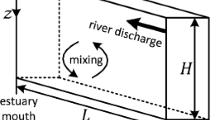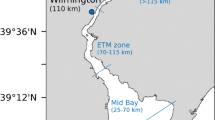Abstract
The effect of upwelling on the preconditions for noxious cyanobacterial blooms in a nitrogen-limited estuary is studied with Nodularia blooms in the Gulf of Finland especially in mind. An idealised physical–chemical model is derived and integrated. The physical development in the model agrees with a classical picture of upwelling for the scales of interest. The chemical component indicates a transient minimum of dissolved inorganic nitrogen to phosphorus ratio in the middle of the gulf, coinciding with the stratification maximum resulting from physical dynamics. A general tendency for offshore cyanobacterial blooms in similar physical and biological conditions is deduced from these results.
Similar content being viewed by others
References
Alenius, P., K. Myrberg & A. Nekrasov, 1998. The physical oceanography of the Gulf of Finland: a review. Boreal Environ. Res. 3(2): 97–125.
Andersen, T., 1997: Pelagic Nutrient Cycles: Herbivores as Sources and Sinks, Vol. 129 of Ecological Studies. Springer.
Bianchi, T. S., E. Engelhaupt, P. Westman, T. Andren, C. Rolff & R. Elmgren, 2000. Cyanobacterial blooms in the Baltic Sea: Natural or human-induced. Limnol. Oceanogr 45(3): 716–726.
Capone, D. G., J. P. Zehr, H. W. Paerl, B. Bergman & E. Carpenter, 1997. Trichodesmium, a globally significant marine cyanobacterium. Nature 276: 1221–1229.
Charney, J. G. & G. R. Flierl, 1981. Oceanic Analogues of Large-Scale Atmospheric Motions. In: Warren, B. A. & C. Wunsch (eds), Evolution of Physical Oceanography. MIT Press, Chapt. 18: 504–548.
Eady, E. T., 1949. Long waves and cyclone waves. Tellus 1(3): 33–52.
Ennet, P., H. Kuosa & R. Tamsalu, 2000. The influence of upwelling and entrainment on the algal bloom in the Baltic Sea. J. mar. Syst. 25: 359–367.
Falkowski, P. G., 2000. Rationalising Elemental Ratios in Unicellular Algae. J. Phycol. 36: 3–6.
Fennel, W., T. Seifert & B. Kayser, 1991. Rossby radii and phase speeds in the Baltic Sea. Cont. Shelf Res. 11: 23–36.
Gill, A., 1982. Atmosphere–Ocean Dynamics. Academic Press.
Kahru, M., B. Håkansson & O. Rud, 1995. Distributions of the Seasurface Temperature Fronts in the Baltic Sea as Derived from Satellite Imagery. Cont. Shelf Res. 15: 663–679.
Kononen, K., J. Kuparinen, K. Mäkelä, J. Laanamets, J. Pavelson & S. Nñmmann, 1996. Initiation of cyanobacterial blooms in a frontal region at the entrance to the Gulf of Finland, Baltic Sea. Limnol. Oceanogr. 41(1): 98–112.
Kuosa, H., 1991. Microbes in the pelagic carbon cycle: picoplanktonic algae and heterotrophic nanoflagellates in the northern Baltic ecosystem. Ph.D. thesis, University of Helsinki, Tvärminne Zoological Station, FIN-10900 Hanko.
Lindström, G., 1855. Bidrag till Kännedomen om Österjöns invertebratfauna. Öfversikt af Kongl. Vetenskapsakad. Förhandlingar 12(2): 49–73.
Mälkki, P. & R. Tamsalu, 1985. Physical Features of the Baltic Sea, Vol. 252 of Finnish Marine Research. Merentutkimuslaitos.
Marshall, J., A. Adcroft, C. Hill, L. Perelman & C. Heisey, 1997. A finite-volume, incompressible Navier Stokes model for studies of the ocean on parallel computers. J. Geophysical Res. 102(C3): 5753–5766.
Moisander, P. H. & H. W. Paerl, 2000. Growth, primary productivity and nitrogen fixation potential of Nodularia spp. (cyanophycae) in water from a subtropical estuary in the United States. J. Phycol. 36: 645–658.
Neumann, T., 2000. Towards a 3D-ecosystem model of the Baltic Sea. J. mar. Syst. 25: 405–419.
Pacanowski, R. C. & S. G. H. Philander, 1981. Parameterization of Vertical Mixing in Numerical Models of Tropical Oceans. J. Physical Oceanogr. 11: 1443–1451.
Pitkänen, H. & T. Tamminen, 1995. Nitrogen and phosphorus as production limiting factors in the estuarine waters of the eastern Gulf of Finland. Mar. Ecol. Prog. Ser. 129: 283–294.
Poutanen, E.-L. & K. Nikkilä, 2001. Carotenoid pigments as tracers of cyanobacterial blooms in recent and post-glacial sediments of the Baltic Sea. Ambio 15: 4–5.
Seifert, T. & B. Kayser, 1995. A high resolution spherical grid topography of the Baltic Sea. Meereswissenschaftliche Berichte 9: 72–88 (summary in German and English).
Sipiä, V., H. Kankaanpää, K. Lahti, W. W. Carmichael & J. Meriluoto, 2001. Detection of Nodularin in Flounders and Cod from the Baltic Sea. Environ. Toxicol. 16: 121–126.
Stipa, T., T. Tamminen & J. Seppälä, 1999. On the creation and maintenance of stratification in the Gulf of Riga. J. mar. Syst. 23: 27–49.
Tuominen, L., K. Mäkelä, K. K. Lehtonen, H. Haahti, S. Hietanen & J. Kuparinen, 1999. Nutrient fluxes, Porewater Profiles and Denitrification in Sediment Influenced by Algal Sedimentation and Bioturbation by Monoporeia affinis. Estuar. coast. shelf Sci. 49: 83–97.
Tyrrell, T., 1999. The relative influences of nitrogen and phosphorus on ocean primary production. Nature 400: 525–531.
Author information
Authors and Affiliations
Rights and permissions
About this article
Cite this article
Stipa, T. The dynamics of the N/P ratio and stratification in a large nitrogen-limited estuary as a result of upwelling: a tendency for offshore Nodularia blooms. Hydrobiologia 487, 219–227 (2002). https://doi.org/10.1023/A:1022990116669
Issue Date:
DOI: https://doi.org/10.1023/A:1022990116669




